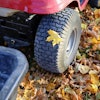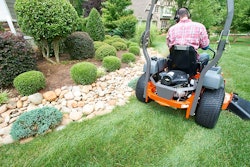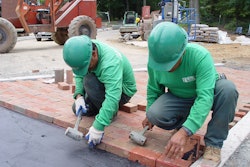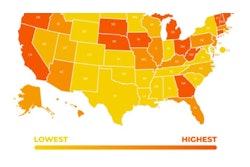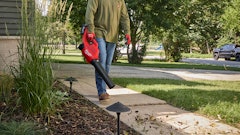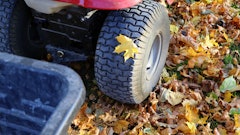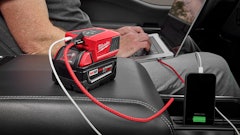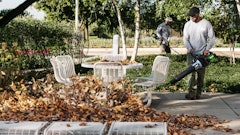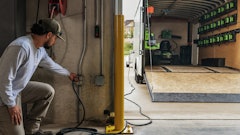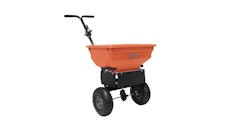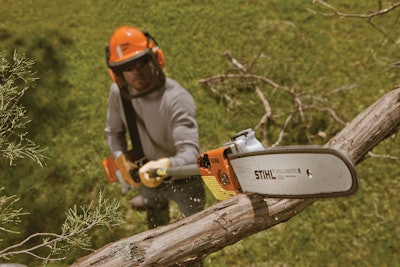
Extended-reach pole pruners can help lawn maintenance crews reach new heights with respect to tree-trimming versatility and productivity. If used carelessly and unsafely, though, your newfound tree-trimming fame can come crashing down on you.
Before you start cutting
Your odds of operating safely will naturally increase if you're using an engine-powered pole saw that is comfortable to use. Power-to-weight and reach are important specs to evaluate.
For example, the Stihl HT 130 Pole Pruner has a 7-foot fixed length and 36.3cc engine, but weighs just 13 pounds or so (without cutting attachment). Stihl's HT 131 has the same 36.3cc engine, features an 11'6" telescoping length, and weighs around 17 pounds. Competitive units of similar length might weigh roughly the same, but the engine is much less powerful; just 21 to 25cc, for example. There are also pole saws out there that are a foot or so longer, obviously weigh even more, but still don't match that 36.3cc engine. So you really must ask yourself: How much reach do I really need, how much power will I have, and how heavy is it going to be?
The next step to safely operating a pole saw, or any piece of outdoor power equipment for that matter, is to make sure you have all of your PPE - personal protective equipment (safety apparel) in order. When operating a pole saw, you'll need the following:
- Eye protection
- Hearing protection
- Helmet
- Non-slip work gloves
- Non-slip work shoes (steel-toed boots advised)
- Long pants (leg chaps also advised)
Additionally, you want to avoid wearing loose-fitting clothing and jewelry, as they can get tangled up in the brush you are cutting or even the saw itself. On that note, also make sure that your shirt or jacket is buttoned up, sleeves included.
Once you have yourself in working order, it's time to make sure your pole saw is. Inspect the chain for missing or heavily worn teeth. Make sure the chain is property oiled and that the automatic bar/chain oiling system is functioning. Look for wear or damage to the guide bar and sprocket. Finally, inspect the saw's safety features to make sure they are in working order, which includes the throttle lever and throttle lockout switch.
Tips for safe sawing
Conditions. First off, think about whether or not the conditions are even right for trimming trees in the first place. If it's really windy or wet and rainy, it might not be a good idea. Also look at what you are planning to trim. You must use extra precaution when working on trees with rotting trunks, loose bark and/or dead branches.
Work area. Observe your work area. Does anything pose a fire threat? Is there anything that could be damaged by falling debris? Is there anything that could pose a trip or slip hazard for you? If so, address it before you start sawing.
Power lines represent a huge area of concern when trimming trees. Maintain a distance of at least 50 feet. The same goes for any electrical source. And the same goes for other people too. Make sure your crewmates and other bystanders steer clear of your work area by at least 50 feet.
Footing. Establish a firm, two-footed footing. Don't stand on anything, which includes a ladder or tree. If you're trimming a tree that's on a hill or slight incline, stand on the high side. That way, if anything were to fall or begin rolling downhill, you won't have to worry about having to dodge it.
Two hands. Just as you want to maintain a secure, two-footed footing, you want to maintain a secure, two-handed grip. First make sure the handles are dry so your hands won't slip. Then, be sure to wrap those fingers and thumbs all the way around and squeeze it tight.
Technique. When starting a cut, you don't want to already be in contact with the branch as your saw will likely jam. Consider starting at a lower throttle before making contact with the branch. Once you have a groove started, throttle up.
A 45° cutting angle is ideal. Go slow and steady, maintaining a secure two-handed grip. Really focus on that last half of the cut, preparing to throttle back and hang on as you complete the cut.
Never over-reach. You can hurt yourself simply as a result of over-extending. But you can also run into other issues as a result of executing a poor cut.
Sometimes jamming or kickback will occur. If your saw jams, shut the engine off and wait a few seconds for all moving parts to stop. Then you can unjam it. Kickback happens when the tip of the guide bar hits an object or when the chain is pinched during a cut. To help avoid kickback, just maintain that sturdy two-handed grip. Then, in tight situations, consider throttling back a bit.
Safety after the saw
When you are done using your engine-powered pole saw, shut the engine off. Keep the blade in front of you and the hot engine muffler away from your body when carrying the saw. When loading the saw back onto the trailer, make sure you attach the guide bar cover, sometimes referred to as a sheath or scabbard.
If anything seemed wrong with the saw, let your boss know right away when you get back to the shop. The last thing you want to do is head back out into the field with a pole saw that isn't going to perform efficiently—and safely—the next day.



